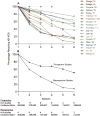Extended-release injectable naltrexone for opioid use disorder: a systematic review
- PMID: 29396985
- PMCID: PMC5993595
- DOI: 10.1111/add.14180
Extended-release injectable naltrexone for opioid use disorder: a systematic review
Abstract
Aims: To review systematically the published literature on extended-release naltrexone (XR-NTX, Vivitrol® ), marketed as a once-per-month injection product to treat opioid use disorder. We addressed the following questions: (1) how successful is induction on XR-NTX; (2) what are adherence rates to XR-NTX; and (3) does XR-NTX decrease opioid use? Factors associated with these outcomes as well as overdose rates were examined.
Methods: We searched PubMed and used Google Scholar for forward citation searches of peer-reviewed papers from January 2006 to June 2017. Studies that included individuals seeking treatment for opioid use disorder who were offered XR-NTX were included.
Results: We identified and included 34 studies. Pooled estimates showed that XR-NTX induction success was lower in studies that included individuals that required opioid detoxification [62.6%, 95% confidence interval (CI) = 54.5-70.0%] compared with studies that included individuals already detoxified from opioids (85.0%, 95% CI = 78.0-90.1%); 44.2% (95% CI = 33.1-55.9%) of individuals took all scheduled injections of XR-NTX, which were usually six or fewer. Adherence was higher in prospective investigational studies (i.e. studies conducted in a research context according to a study protocol) compared to retrospective studies of medical records taken from routine care (6-month rates: 46.7%, 95% CI = 34.5-59.2% versus 10.5%, 95% CI = 4.6-22.4%, respectively). Compared with referral to treatment, XR-NTX reduced opioid use in adults under criminal justice supervision and when administered to inmates before release. XR-NTX reduced opioid use compared with placebo in Russian adults, but this effect was confounded by differential retention between study groups. XR-NTX showed similar efficacy to buprenorphine when randomization occurred after detoxification, but was inferior to buprenorphine when randomization occurred prior to detoxification.
Conclusions: Many individuals intending to start extended-release naltrexone (XR-NTX) do not and most who do start XR-NTX discontinue treatment prematurely, two factors that limit its clinical utility significantly. XR-NTX appears to decrease opioid use but there are few experimental demonstrations of this effect.
Keywords: Extended-release; heroin; injectable; medication-assisted treatment; naltrexone; opioid use disorder; prescription opioids.
© 2018 Society for the Study of Addiction.
Conflict of interest statement
Figures



Comment in
-
Long-acting naltrexone has long-acting benefits and 100% induction rates are not difficult to achieve.Addiction. 2019 Jan;114(1):188-189. doi: 10.1111/add.14448. Epub 2018 Oct 30. Addiction. 2019. PMID: 30345573 No abstract available.
-
Extended-release injectable naltrexone (XR-NTX): a response to clinical issues raised by Brewer & Streel.Addiction. 2019 Jan;114(1):189-190. doi: 10.1111/add.14462. Epub 2018 Oct 30. Addiction. 2019. PMID: 30345640 No abstract available.
Similar articles
-
Effectiveness, safety and feasibility of extended-release naltrexone for opioid dependence: a 9-month follow-up to a 3-month randomized trial.Addiction. 2018 Oct;113(10):1840-1849. doi: 10.1111/add.14278. Epub 2018 Jun 22. Addiction. 2018. PMID: 29806872
-
Initiation of extended release naltrexone (XR-NTX) for opioid use disorder prior to release from prison.J Subst Abuse Treat. 2018 Feb;85:45-48. doi: 10.1016/j.jsat.2017.04.010. Epub 2017 Apr 19. J Subst Abuse Treat. 2018. PMID: 28527855 Free PMC article. Clinical Trial.
-
Predictors of induction onto extended-release naltrexone among unemployed heroin-dependent adults.J Subst Abuse Treat. 2018 Feb;85:38-44. doi: 10.1016/j.jsat.2017.04.012. Epub 2017 Apr 20. J Subst Abuse Treat. 2018. PMID: 28449955 Free PMC article. Clinical Trial.
-
Extended-release intramuscular naltrexone (VIVITROL®): a review of its use in the prevention of relapse to opioid dependence in detoxified patients.CNS Drugs. 2013 Oct;27(10):851-61. doi: 10.1007/s40263-013-0110-x. CNS Drugs. 2013. PMID: 24018540 Review.
-
Intramuscular extended-release naltrexone: current evidence.Ann N Y Acad Sci. 2011 Jan;1216:144-66. doi: 10.1111/j.1749-6632.2010.05900.x. Ann N Y Acad Sci. 2011. PMID: 21272018 Review.
Cited by
-
The effects of naltrexone on retention in treatment and being opioid-free in opioid-dependent people: A systematic review and meta-analysis.Front Psychiatry. 2022 Sep 26;13:1003257. doi: 10.3389/fpsyt.2022.1003257. eCollection 2022. Front Psychiatry. 2022. PMID: 36226100 Free PMC article.
-
Effect of Relaxation-Based Virtual Reality on Psychological and Physiological Stress of Substance Abusers Under Detoxification: A Randomized Controlled Trial.Brain Behav. 2024 Oct;14(10):e70084. doi: 10.1002/brb3.70084. Brain Behav. 2024. PMID: 39402817 Free PMC article. Clinical Trial.
-
The Affordable Care Act In The Heart Of The Opioid Crisis: Evidence From West Virginia.Health Aff (Millwood). 2019 Apr;38(4):633-642. doi: 10.1377/hlthaff.2018.05049. Health Aff (Millwood). 2019. PMID: 30933592 Free PMC article.
-
Who stays in medication treatment for opioid use disorder? A national study of outpatient specialty treatment settings.J Subst Abuse Treat. 2021 Jul;126:108329. doi: 10.1016/j.jsat.2021.108329. Epub 2021 Feb 18. J Subst Abuse Treat. 2021. PMID: 34116820 Free PMC article.
-
Potential Risk Window for Opioid Overdose Related to Treatment with Extended-Release Injectable Naltrexone.Drug Saf. 2018 Oct;41(10):979-980. doi: 10.1007/s40264-018-0705-8. Drug Saf. 2018. PMID: 30073490 Free PMC article. No abstract available.
References
-
- Degenhardt L, Charlson F, Mathers B, Hall WD, Flaxman AD, Johns N, et al. The global epidemiology and burden of opioid dependence: Results from the global burden of disease 2010 study. Addiction. 2014;109:1320–1333. - PubMed
-
- Han B, Compton WM, Jones CM, Cai R. Nonmedical prescription opioid use and use disorders among adults aged 18 through 64 years in the United States, 2003–2013. JAMA. 2015;314:1468–1478. - PubMed
-
- Frank RG, Pollack HA. Addressing the fentanyl threat to public health. N Engl J Med. 2017;376:605–607. - PubMed
-
- Murthy VH. Ending the opioid epidemic—A call to action. N Engl J Med. 2016;375:2413–2415. - PubMed
Publication types
MeSH terms
Substances
Grants and funding
LinkOut - more resources
Full Text Sources
Other Literature Sources
Medical

